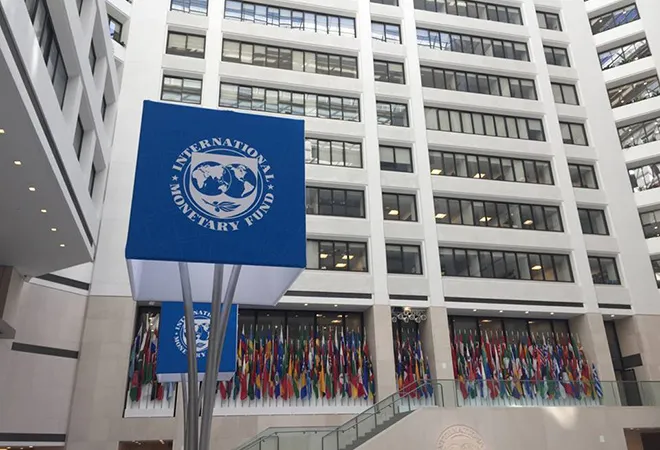-
CENTRES
Progammes & Centres
Location
The recent climate resilience loan packages that has been introduced by the IMF fall short

Climate change and pandemic preparedness are challenges that seriously threaten low-income and vulnerable middle-income countries. The International Monetary Fund (IMF) set up a lending toolkit called the Resilience and Sustainability Trust (RST) to help address these challenges. The first tranche of loans was given to five countries: Costa Rica, Barbados, Jamaica, Bangladesh and the Seychelles—all of them are vulnerable to climate change. But an analysis of the terms and conditions of the structure shows that it does not go far enough to be an effective tool to combat the large and looming issues.
Why RST?
The role of RST is to complement IMF’s loans that are currently accessible to all countries under the General Resources Account (GRA) sources, and to low-income countries under the Poverty Reduction and Growth Trust (PRGT). These existing instruments are used by members facing short- and medium-term challenges. The goal of RST is to broaden the lending support by providing affordable and longer-term financing to enhance economic resilience and sustainability.
RST hopes to support climate-vulnerable countries in reducing and managing macro-financial risks stemming from climate change. It is a concessional debt financing facility with a repayment period of 20 years and a 10.5-year grace period. The RST funding will be priced modestly with a margin of up to 100 basis points (in three tiers) over the three-month Special Drawing Rights (SDR) interest rate.
The role of RST is to complement IMF’s loans that are currently accessible to all countries under the General Resources Account (GRA) sources, and to low-income countries under the Poverty Reduction and Growth Trust (PRGT).
The access cap for eligible members is lower than 150 percent of the quota or SDR 1 billion. The starting point of access determination is an access norm of 75 percent of the quota – the maximum amount IMF gives as loans to member countries.
Some examples
A look at the recent RST loans provides a glimpse of the practical aspects of the program. For one, the loan sizes varied widely for countries, from US$183 million for Barbados to US$1.4 billion for Bangladesh. Also, the use cases were customised. For instance, Jamaica’s loan was intended for reforms aimed at creating incentives to switch to renewables, increase energy efficiency, develop green financial instruments, and manage climate risks in the financial sector. These reforms are expected to catalyse private and official financing for climate-related investment.
For Bangladesh, the RST complemented other IMF loans that are intended to support macroeconomic stability and lay the foundations for strong, inclusive, and environmentally-sustainable growth. RST aims to supplement other available loans by expanding the fiscal space to finance climate action priorities and catalyse additional financing, and make the economy climate resilient.
Few shortcomings
That said, according to IMF’s own estimate, the one-time US$1.4 billion loan is extremely low compared to the country’s annual climate-related investment of US$12 to 16 billion. Also, Bangladesh is not able to design its own economic policies as the stringent conditions of the RST loan are not different from earlier loan packages. For example, the terms require the country to increase government revenue, make fuel-price market-driven, liberalise the domestic electricity sector, and limit public spending—economic measures that have little to do with climate action.
The loan facility also has a few limitations on its effectiveness. For one, RST will not make much of a dent in small and vulnerable countries as the loan quota is tied to their SDR quota, which is dependent on GDP size. The small loans can do little to address the financing needs of the smaller countries with small economies but a high need for climate financing.
Two, there are stringent conditions and eligibility criteria that limit the reach. The facility depends on whether the countries have the ability to pay back, which may make it difficult for vulnerable countries to qualify. Even if one qualifies, providing more loans to countries that are already burdened with high debt may aggravate the situation. Too much debt can reduce the fiscal space for climate mitigation and adaptation investments.
Three, the interest rates charged are not very different from what IMF charges middle-income countries (MICs). It is not seen as concessional by small countries and there is an additional service charge of up to 50 basis points.
RST will not make much of a dent in small and vulnerable countries as the loan quota is tied to their SDR quota, which is dependent on GDP size.
Four, even if countries take up this facility, it is very small vis-à-vis the need. The annual climate adaptation costs for developing countries are projected to be US$140-300 billion by 2030 and US$280-500 billion by 2050. This is nowhere close to being met by the US$50 billion size suggested by IMF’s Managing Director for this facility.
Five, the mechanism doesn’t address the serious challenge of the need to be just and inclusive in the green transition, faced by developing countries. A forced green transition not well aligned with the just in transition principle will be a penalty, instead of a panacea.
Effective remedy
The RST's size and role is currently uncertain and will depend on countries' interest in channeling their SDRs. It is therefore important for the RST to show that it provides an additional benefit to the IMF's existing lending resources and does not displace these.
To make the RST truly catalytic and genuinely concessional, the size and quota of the fund should be increased and replenished every year, and make it a zero-interest loan like the Poverty Reduction and Growth Trust.
Additionally, the RST should work together with the World Bank and other international public financial institutions to support climate financing. The World Bank has historically been the primary source of climate financing among them. Therefore, it is crucial to have a cohesive strategy among these institutions to address climate change effectively.
Labanya Prakash Jena is the Regional Climate Finance Adviser Indo-Pacific Region at the Commonwealth Secretariat.
Meera Siva is an impact investor and currently manages a global equity fund focussed on affordable housing.
The views expressed above belong to the author(s). ORF research and analyses now available on Telegram! Click here to access our curated content — blogs, longforms and interviews.

Labanya Prakash Jena is Director at the Climate and Sustainability Initiative (CSI) and a visiting senior fellow at the London School of Economics and Political ...
Read More +
Meera Siva is an impact investor and currently manages a global equity fund focussed on affordable housing.
Read More +